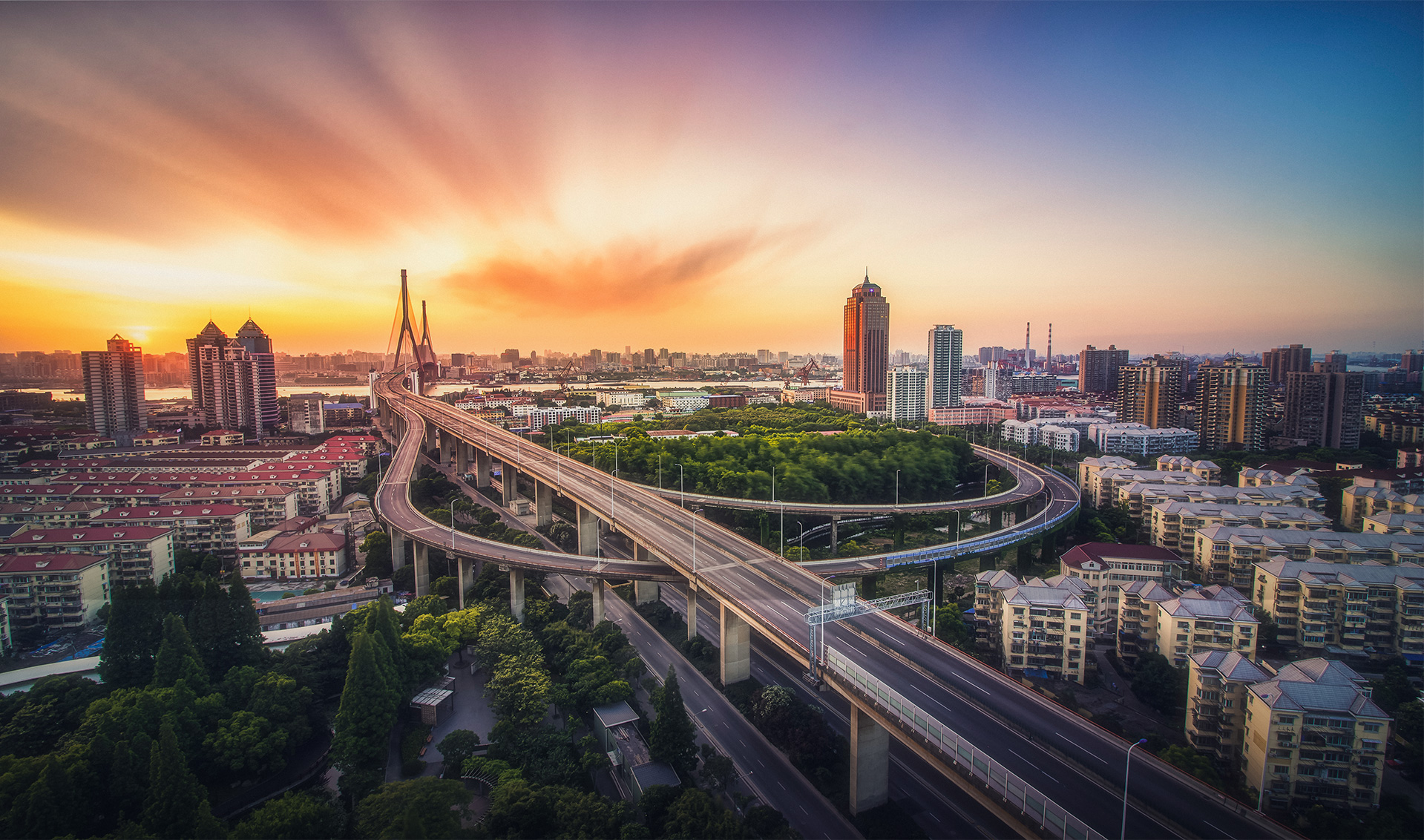
Comprise All Urban Roadway Lighting Design Solutions
Urban street lighting design solutions are based on different road scenarios. Different urban roads have their own features. BOSUN Light is dedicated to maximizing advantages for the ultimate ideal illumination to benefit people.
Commonly Used Scenarios for Solar Street Lights on City Roads
Solar street lights are increasingly becoming the go-to solution for city roads due to their energy efficiency, sustainability, and ease of installation. They are ideal for various urban roadways, including residential streets, arterial roads, highways, and public spaces. Below, we'll explore four common application scenarios for solar street lights in city road settings, explaining why each needs solar lighting and providing design solutions tailored to these specific needs.
Road Classification & Illuminance Levels
Urban roads are classified based on traffic volume and function, which determines the required lighting level:
| Road Type | Illuminance (Lux) | Uniformity (U₀) | Glare Control (TI%) |
| Expressways (high-speed roads) | 20–50 lx | ≥ 0.4 | ≤ 10% |
| Main Roads (arterial roads) | 15–30 lx | ≥ 0.4 | ≤ 15% |
| Secondary Roads (collector roads) | 10–20 lx | ≥ 0.35 | ≤ 15% |
| Local Streets (residential roads) | 5–15 lx | ≥ 0.3 | ≤ 20% |
Uniformity & Luminance Requirements
Luminance (cd/m²): The brightness of the road surface should be consistent for driver visibility.
Uniformity (U₀ = Min/Avg Luminance): Ensures even distribution of light to avoid dark patches.
Glare Control (TI - Threshold Increment %): Limits excessive brightness contrast that may affect drivers' vision.
Residential Streets
Why Do These Streets Need Solar Street Lights?
Residential streets typically require adequate lighting for security, pedestrian safety, and aesthetics. With the need to reduce energy costs and minimize infrastructure installation, solar street lights are the perfect solution. They operate off-grid, reducing reliance on electricity networks and providing continuous lighting through renewable energy.
Design Solution:
Lighting Type: Use all-in-one solar street lights with LED technology, ideally ranging from 30W to 50W, for soft, non-glare illumination suitable for residential areas.
Battery Capacity: Choose batteries that provide 10-12 hours of lighting. Lithium-ion batteries are ideal due to their longer lifespan and efficient energy storage.
Pole Height & Spacing: Install poles at a height of 4-6 meters, spaced approximately 15-20 meters apart, to cover typical street lengths while avoiding over-lighting and light pollution.
Solar Panel Positioning: Panels should be angled at 30-45 degrees and placed on top of the pole or on nearby rooftops to maximize solar absorption.
Smart Features: Integrate motion sensors to adjust the brightness when there is pedestrian or vehicle movement, further optimizing energy usage.
Materials: Use weather-resistant materials like aluminum or galvanized steel to withstand various weather conditions.
Arterial Roads
Why Do These Roads Need Solar Street Lights?
Arterial roads are busy thoroughfares connecting neighborhoods and commercial areas. They require bright, high-efficiency lighting to ensure safety for both vehicles and pedestrians, especially at night. Solar street lights provide a sustainable solution, offering powerful illumination while minimizing the strain on the electrical grid.
Design Solution:
Lighting Type: Use high-lumen LED solar street lights ranging from 100W to 150W to ensure high visibility for traffic and pedestrians.
Battery Capacity: Opt for high-capacity batteries that offer up to 12-14 hours of lighting, ensuring that even during long nights or cloudy days, the road remains illuminated.
Pole Height & Spacing: Install poles at a height of 8-10 meters with a spacing of 30-35 meters between poles for maximum coverage, providing evenly distributed light on both sides of the road.
Solar Panel Positioning : Panels should be tilted at an optimal angle (around 30-45 degrees) and ideally positioned to avoid any obstructions like nearby trees or buildings.
Smart Features: Implement adaptive lighting control systems with dimming features to optimize energy consumption when traffic is low.
Materials: Use corrosion-resistant materials, such as galvanized steel poles and UV-resistant lamp covers, to extend the life of the street light.
Highway Lighting
Why Do These Roads Need Solar Street Lights?
Highways are critical for long-distance travel and require high-performance lighting to ensure road safety, particularly for night drivers. Installing traditional grid-connected streetlights on highways is expensive and often impractical. Solar street lights provide an effective, cost-efficient solution, especially for isolated or rural highway sections.
Design Solution:
Lighting Type: Use high-powered LED solar street lights ranging from 150W to 250W to ensure that highways are well-lit for fast-moving traffic.
Battery Capacity: Choose solar street lights with high-capacity batteries capable of providing 15+ hours of consistent illumination, even in areas with limited sunlight exposure.
Pole Height & Spacing: Install poles at a height of 10-12 meters, spaced 40-50 meters apart, depending on the road width and the desired level of illumination. This ensures ample lighting for vehicles traveling at high speeds.
Solar Panel Positioning: Panels should be placed at an optimal angle (typically 30-45 degrees) on top of the pole or on specialized mounting structures. Ensure no shadowing from surrounding objects.
Smart Features: Integrate GPS and IoT-based monitoring systems to remotely track performance, battery levels, and lighting status, especially useful for remote highway sections.
Materials: Use durable, anti-corrosive materials like stainless steel or aluminum poles and IP65-rated fixtures to protect against rain, dust, and extreme weather conditions.
Public Spaces and Urban Parks
Why Do These Areas Need Solar Street Lights?
Urban parks, plazas, and public spaces require well-planned lighting solutions to enhance safety, aesthetics, and energy efficiency. Solar street lights in these areas provide adequate illumination for recreational activities while offering a sustainable, low-maintenance alternative to grid-powered lighting.
Design Solution:
Lighting Type: Use decorative solar street lights with a lumen range of 40W to 80W, designed to create an ambient atmosphere for both safety and aesthetics.
Battery Capacity: Use batteries that provide 10-12 hours of lighting per night, ensuring continuous illumination throughout the evening.
Pole Height & Spacing: Poles should be installed at a height of 6-8 meters, with spacing between poles around 15-20 meters for efficient coverage without over-lighting the space.
Solar Panel Positioning: Install solar panels on rooftops, poles, or ground-mounted platforms with an adjustable angle for maximum sunlight absorption. The panels should be positioned away from large obstructions to ensure optimal solar energy capture.
Smart Features: Integrate sensors and automatic dimming to enhance energy efficiency based on foot traffic or time of day.
Aesthetics: Choose solar street lights that complement the park’s natural beauty and architectural style, blending functionality with visual appeal.
